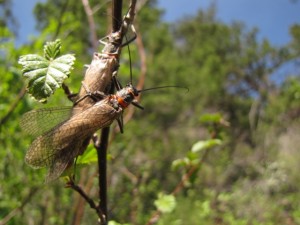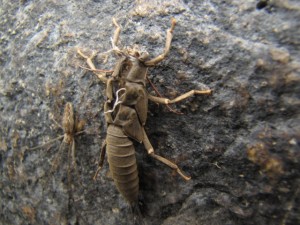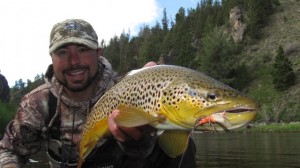Salmon Flies
Salmon Flies on the North Platte
Every year Diehard fly fishermen flock to the Rocky Mountains from far and wide to get a crack at this hatch. Whether they’re luck is good or bad, any angler who gets the chance to witness this hatch in its pure form will be changed forever?
The Salmon fly hatch on any river, not just the North Platte is fairly predictable. It always seems to show up in late May or early June. Depending on who you talk to, the hatch is stimulated by; time of day, length of day, water temp, water flow, air temp, moon phase, length of day, etc… Whatever or whichever it is that gets these bugs out of the river and flying around like B52 Bombers is a mystery to me, but what I do know is that when they’re out it doesn’t matter how big the water flow is, how cold, or what time of day it is, every damn fish in the river knows it, and all they want to do is EAT.
Salmon Flies (Pteronarcy’s, Californica)
Salmon Flies (Pteronarcy’s, Californica) are in the Stonefly family and the King of their species. Salmon flies have a life span of four years from nymph stage to a hatched Adult. Salmonfly nymphs develop for three years before emerging. This means that in the months prior to the hatch, there are three sizes in the river. After the hatch, there are only two. The nymphs congregate to the deep darker boulder sections of the rivers and live under large boulders and in deep crevices. As their emergence date approaches, they migrate into the shallows at preferred locations. Anglers can cover long sections without seeing any signs of the nymphs then turn one corner and see thousands of them. It’s very wise for anglers to identify these areas and fish them prior to the hatch when the brood nymphs are very active. The best way to locate brood nymphs ready to hatch is to kick rocks around within the first three feet of the bank and collect the bugs with a seine net. If you happen to find a honey hole you’ll know it and be in luck because it’s some of the best nymph fishing of the year. When they are ready, they crawl out of the water onto exposed cobble or riparian plant life to split their husks and emerge. This usually takes place in the early morning hours but can also take place in the evening or midday under cloud cover. The Adults will fly around high in the sky in search of their mates. Once a mate is found they will spend time in the high trees and willows mating. It is the egg laying females that cause the bulk of the dry fly action. Though some are known to land and lay their eggs, most females fly low over the water in a lumbering flight path and drop their large pea sized olive black egg sacks from above. They aren’t the best fliers and North Park’s ever present breezes often knock them to the water. Sometimes they flop around on the surface for awhile and in softer water they will ride docilely with their wings folded. This is when the trout are really fired up and eating them off the surface.
Living and working in North Park, I’ve been fascinated with this hatch for 10 years and have witnessed everything from all out blizzard hatches that lasted a week to 10 days to very short hatches that only last 1-2 days. Every year is different and that’s what’s interesting. For me, trying to time this hatch every season has become a never-ending obsession and a more important role in managing a guide service on the river. I’ve developed my own theories and all though not perfect they have been very consistent the past 4-6 years. Instead of looking closely at the weather pattern, water flows, water temps, and length of day, I like to look back at my journal and see what date it was 3 ½ years ago when these bugs hatched and guess that the brood nymphs ready to hatch the coming year should be somewhat close to when they were dropped into the river. This has proven to be a very good tool for us. By knowing the time-frame they were dropped in the river 3 ½ years ago we can expect to see the upcoming hatch to be somewhat close to that of their parents. Trying to time this hatch can be discouraging but if you hit it right it’s very rewarding and insanely fun.
The North Platte is a freestone system and solely relies on winter’s snow-pack for the upcoming stream flows. Usually the river is in a run-off stage in late May and early June but due to upstream irrigation the river is lower and clearer than it normally would be at that time. The upper valley acts like a giant filter while ranchers are pulling out water for hayfield’s during May and June. Essentially all the muddy runoff water is filtered through the hayfield’s and returned back to the river clearer and warmer before entering the canyon stretch where this hatch occurs. This provides anglers an amazing opportunity to fish the prolific salmonfly hatch with success. Managing a guide service on this river has awarded us the opportunity to get very intimate with the bugs that thrive in it. A few of our favorites include Green Drakes, PMD’s, and Tricos, but none of them demand quite the same respect as the Salmonfly.
Over the past 10 years, I’ve witnessed 5 extremely good hatches that had every fish in the river feeding on giant salmonflies. Whether by myself or with clients each hatch was so incredible that you actually get tired of casting and just want to crack a cold PBR and enjoy the scene. When it’s really good you don’t have to see a rise to know where the fish are, you’ll hear the GULP. In 2009 the bugs came off intensely but we harbored a 48 hour downpour that raised the river by 1500 cfs and killed the hatch, just as soon as the fish knew they were around the bugs were gone. In 2011 we had a 400 year record high snow pack, the Salmon fly hatch was the largest we’ve seen to date and it lasted for 8-10 days but no one except the fish were able to enjoy it because of the size of the river. Conversely, in 2012 the river was at a 100 year low. The hatch was good, I’d give it 6 out of 10 in comparison to all the hatches I’ve fished on this particular river. The difference was that the river was so low that we could wade the river like it was September. I was literally able to put a back pack on and follow the hatch upstream which on any other year was never possible due to the size of the river. In general the only way to get a crack at this hatch is by floating. But last year I was able to walk up the middle of the river casting to every fish that showed his face. I can’t tell you how many fish I caught but what I can tell you is that it was the highlight of my fishing days and a fabulous way to celebrate a 10 year reunion with this outstanding creature. It was 10 out of 10 and I don’t expect to get that lucky again for some time!
Looking forward to 2014 we expect to have another great hatch. With heavier snow-pack than last year we expect to get a nice run off that should clean the system with ease. In my experience the best years for the Salmon fly hatch when thinking in terms of fish-ability, has always come on the heels of snow-pack from 100-120% of average. The river always seems to have perfect flows and clarity making it easy for the fish to find cover and get a good look at the bugs which in turn is great for us as anglers.







